Abstract
Introduction
This study evaluated nerve recovery through retrospective study of patients with lingual nerve damage.
Patients and Methods
The patients who visited Seoul National University Dental Hospital for an injury to the lingual nerve from April 1988 to August 2009 were enrolled in this study (n=41). The relevance of various factors including the causes of damage, age, etc. was analyzed by the subjective improvement based upon questionnaires and the clinical records. The evaluation variants were a subjective assessment and neurosensory examination composed of the direction, contact threshold, two-point discrimination, pin prick, thermal discrimination and current perception threshold.
Results
The causes of lingual nerve damage were an extraction of the lower third molar (75.6%), local anesthesia (9.7%), incision and drainage (4.88%), trauma (2.44%). The evaluation of subjective prognosis exhibited no difference in sensory improvement depending on the cause, age and gender. Based upon the subjective evaluation, 44.7% of patients showed sensory improvement. The first hospital visit from injury was shorter in the group showing subjective improvement (3.41 months) than those showing no improvement (5.24 months) (P=0.301). Thirty six out of 41 patients were treated with only conservative therapy and 5 patients were treated by surgical intervention. Neurosensory examinations revealed improvement, although not statistically significant, and the degree was higher in the subjectively improved group. The contact threshold discrimination showed the highest correlation with subjective improvement (P=0.069). Most of the sensory recovery was gained within 12 months and the degree of improvement at the tip of the tongue was higher than that of the dorsum (P<0.001).
Conclusion
The damaged lingual nerve improved at a rate of 44.7% and mostly within 12 months after the incident. There was no difference between the subjective prognosis and neurosensory examination depending on the cause of damage, age and gender, whereas the contact threshold discrimination was the best variant that reflected the subjective prognosis statistically.
Go to : 
References
1. Fielding AF, Rachiele DP, Frazier G. Lingual nerve paresthesia following third molar surgery: a retrospective clinical study. Oral Surg Oral Med Oral Pathol Oral Radiol Endod. 1997; 84:345–8.
2. Blackburn CW, Bramley PA. Lingual nerve damage associated with the removal of lower third molars. Br Dent J. 1989; 167:103–7.

3. Black CG. Sensory impairment following lower third molar surgery: a prospective study in New Zealand. N Z Dent J. 1997; 93:68–71.
4. Wofford DT, Miller RI. Prospective study of dysesthesia following odontectomy of impacted mandibular third molars. J Oral Maxillofac Surg. 1987; 45:15–9.

5. Krafft TC, Hickel R. Clinical investigation into the incidence of direct damage to the lingual nerve caused by local anaesthesia. J Craniomaxillofac Surg. 1994; 22:294–6.

6. Karas ND, Boyd SB, Sinn DP. Recovery of neurosensory function following orthognathic surgery. J Oral Maxillofac Surg. 1990; 48:124–34.

7. Chiapasco MDe Cicco L, Marrone G. Side effects and complications associated with third molar surgery. Oral Surg Oral Med Oral Pathol. 1993; 76:412–20.
8. Middlehurst RJ, Barker GR, Rood JP. Postoperative morbidity with mandibular third molar surgery: a comparison of two techniques. J Oral Maxillofac Surg. 1988; 46:474–6.

9. Carmichael FA, McGowan DA. Incidence of nerve damage following third molar removal: a West of Scotland Oral Surgery Research Group study. Br J Oral Maxillofac Surg. 1992; 30:78–82.

10. Han S. National survey of inferior alveolar nerve and lingual nerve damage after lower third molar extraction. J Korean Dent Assoc. 2009; 47:211–24.
11. Mason DA. Lingual nerve damage following lower third molar surgery. Int J Oral Maxillofac Surg. 1988; 17:290–4.

12. Hillerup S, Stoltze K. Lingual nerve injury in third molar surgery I. Observations on recovery of sensation with spontaneous healing. Int J Oral Maxillofac Surg. 2007; 36:884–9.
13. Lee JH, Lee SY, Song SI, Lee EJ, Ahn KM, Kim SM, et al. Sensory normative values of lower lip and tongue for evaluation of inferior alveolar or lingual nerve damage. J Korean Assoc Maxillofac Plast Reconstr Surg. 2003; 25:114–22.
14. Sunderland S. A classification of peripheral nerve injuries producing loss of function. Brain. 1951; 74:491–516.

15. Robinson PP, Loescher AR, Smith KG. A prospective, quantitative study on the clinical outcome of lingual nerve repair. Br J Oral Maxillofac Surg. 2000; 38:255–63.

16. Rath EM, Essick GK. Perioral somesthetic sensibility: do the skin of the lower face and the midface exhibit comparable sensitivity? J Oral Maxillofac Surg. 1990; 48:1181–90.

17. Pogrel MA, Thamby S. Permanent nerve involvement resulting from inferior alveolar nerve blocks. J Am Dent Assoc. 2000; 131:901–7.
18. Venta ¨ I, Lindqvist C, Ylipaavalniemi P. Malpractice claims for permanent nerve injuries related to third molar removals. Acta Odontol Scand. 1998; 56:193–6.
19. Hillerup S, Hj � rting-Hansen E, Reumert T. Repair of the lingual nerve after iatrogenic injury: a follow-up study of return of sensation and taste. J Oral Maxillofac Surg. 1994; 52:1028–31.
20. Hillerup S. Iatrogenic injury to oral branches of the trigeminal nerve: records of 449 cases. Clin Oral Investig. 2007; 11:133–42.

21. Sandstedt P, So ¨rensen S. Neurosensory disturbances of the trigeminal nerve: a longterm follow-up of traumatic injuries. J Oral Maxillofac Surg. 1995; 53:498–505.
22. Lautenbacher S, Kunz M, Strate P, Nielsen J, Arendt-Nielsen L. Age effects on pain thresholds, temporal summation and spatial summation of heat and pressure pain. Pain. 2005; 115:410–8.

23. Harn SD, Durham TM. Incidence of lingual nerve trauma and postinjection complications in conventional mandibular block anesthesia. J Am Dent Assoc. 1990; 121:519–23.

24. Pogrel MA, Kaban LB. Injuries to the inferior alveolar and lingual nerves. J Calif Dent Assoc. 1993; 21:50–4.
25. Robinson PP, Winkles PA. The number and distribution of fungiform papillae and taste buds after lingual nerve injuries in cats. Arch Oral Biol. 1991; 36:885–91.

26. Dao TT, Mellor A. Sensory disturbances associated with implant surgery. Int J Prosthodont. 1998; 11:462–9.
27. Teerijoki-Oksa T, Ja ¨a ¨skela ¨inen S, Forssell K, Virtanen A, Forssell H. An evaluation of clinical and electrophysiologic tests in nerve injury diagnosis after mandibular sagittal split osteotomy. Int J Oral Maxillofac Surg. 2003; 32:15–23.

28. Sunderland S. Factors influencing the course of regeneration and the quality of the recovery after nerve suture. Brain. 1952; 75:19–54.

29. Robinson PP, Smith KG. A study on the efficacy of late lingual nerve repair. Br J Oral Maxillofac Surg. 1996; 34:96–103.

30. Westermark A, Englesson L, Bongenhielm U. Neurosensory function after sagittal split osteotomy of the mandible: a comparison between subjective evaluation and objective assessment. Int J Adult Orthodon Orthognath Surg. 1999; 14:268–75.
31. Leira JI, Gilhuus-Moe OT. Sensory impairment following sagittal split osteotomy for correction of mandibular retrognathism. Int J Adult Orthodon Orthognath Surg. 1991; 6:161–7.
32. Essick GK. Comprehensive clinical evaluation of perioral sensory function. Oral Maxillofac Surg Clin North Am. 1992; 4:503–526.

33. Blomqvist JE, Alberius P, Isaksson S. Sensibility following sagittal split osteotomy in the mandible: a prospective clinical study. Plast Reconstr Surg. 1998; 102:325–33.

34. Chen N, Neal CE, Lingenbrink P, Bloomquist D, Kiyak HA. Neurosensory changes following orthognathic surgery. Int J Adult Orthodon Orthognath Surg. 1999; 14:259–67.
35. Campbell RL, Shamaskin RG, Harkins SW. Assessment of recovery from injury to inferior alveolar and mental nerves. Oral Surg Oral Med Oral Pathol. 1987; 64:519–26.

36. Ylikontiola L, Kinnunen J, Oikarinen K. Comparison of different tests assessing neurosensory disturbances after bilateral sagittal split osteotomy. Int J Oral Maxillofac Surg. 1998; 27:417–21.
37. Poort LJ, van Neck JW, van der Wal KG. Sensory testing of inferior alveolar nerve injuries: a review of methods used in prospective studies. J Oral Maxillofac Surg. 2009; 67:292–300.

38. Ziccardi VB, Hullett JS, Gomes J. Physical neurosensory testing versus current perception threshold assessment in trigeminal nerve injuries related to dental treatment: a retrospective study. Quintessence Int. 2009; 40:603–9.
39. Kipp DP, Goldstein BH, Weiss WW Jr. Dysesthesia after mandibular third molar surgery: a retrospective study and analysis of 1,377 surgical procedures. J Am Dent Assoc. 1980; 100:185–92.

40. Behnia H, Kheradvar A, Shahrokhi M. An anatomic study of the lingual nerve in the third molar region. J Oral Maxillofac Surg. 2000; 58:649–51. discussion 652–3.

41. Chossegros C, Guyot L, Cheynet F, Belloni D, Blanc JL. Is lingual nerve protection necessary for lower third molar germecto-my? A prospective study of 300 procedures. Int J Oral Maxillofac Surg. 2002; 31:620–4.

42. Girard KR. Considerations in the management of damage to the mandibular nerve. J Am Dent Assoc. 1979; 98:65–71.

43. Posnick JC, Zimbler AG, Grossman JA. Normal cutaneous sensibility of the face. Plast Reconstr Surg. 1990; 86:429–33. discussion 434–5.

44. Robinson PP. The effect of injury on the properties of afferent fibres in the lingual nerve. Br J Oral Maxillofac Surg. 1992; 30:39–45.

45. LaBanc JP, Gregg JM. Trigeminal nerve injury. Basic problems, historical perspectives, early successes and remaining challenges. LaBanc JP, Gregg JM, editors. eds:. Oral and Maxillofacial Surgery Clinics of North America: Trigeminal Nerve Injury: Diagnosis and Management. Philadelphia: WB Saunders;1992. p. 277–83.
46. Bagheri SC, Meyer RA, Khan HA, Kuhmichel A, Steed MB. Retrospective review of microsurgical repair of 222 lingual nerve injuries. J Oral Maxillofac Surg. 2010; 68:715–23.

47. Ja ¨a ¨skela ¨inen SK, Teerijoki-Oksa T, Virtanen A, Tenovuo O, Forssell H. Sensory regeneration following intraoperatively verified trigeminal nerve injury. Neurology. 2004; 62:1951–7.

48. Kobayashi A, Yoshimasu H, Kobayashi J, Amagasa T. Neurosensory alteration in the lower lip and chin area after orthognathic surgery: bilateral sagittal split osteotomy versus inverted L ramus osteotomy. J Oral Maxillofac Surg. 2006; 64:778–84.

Go to : 
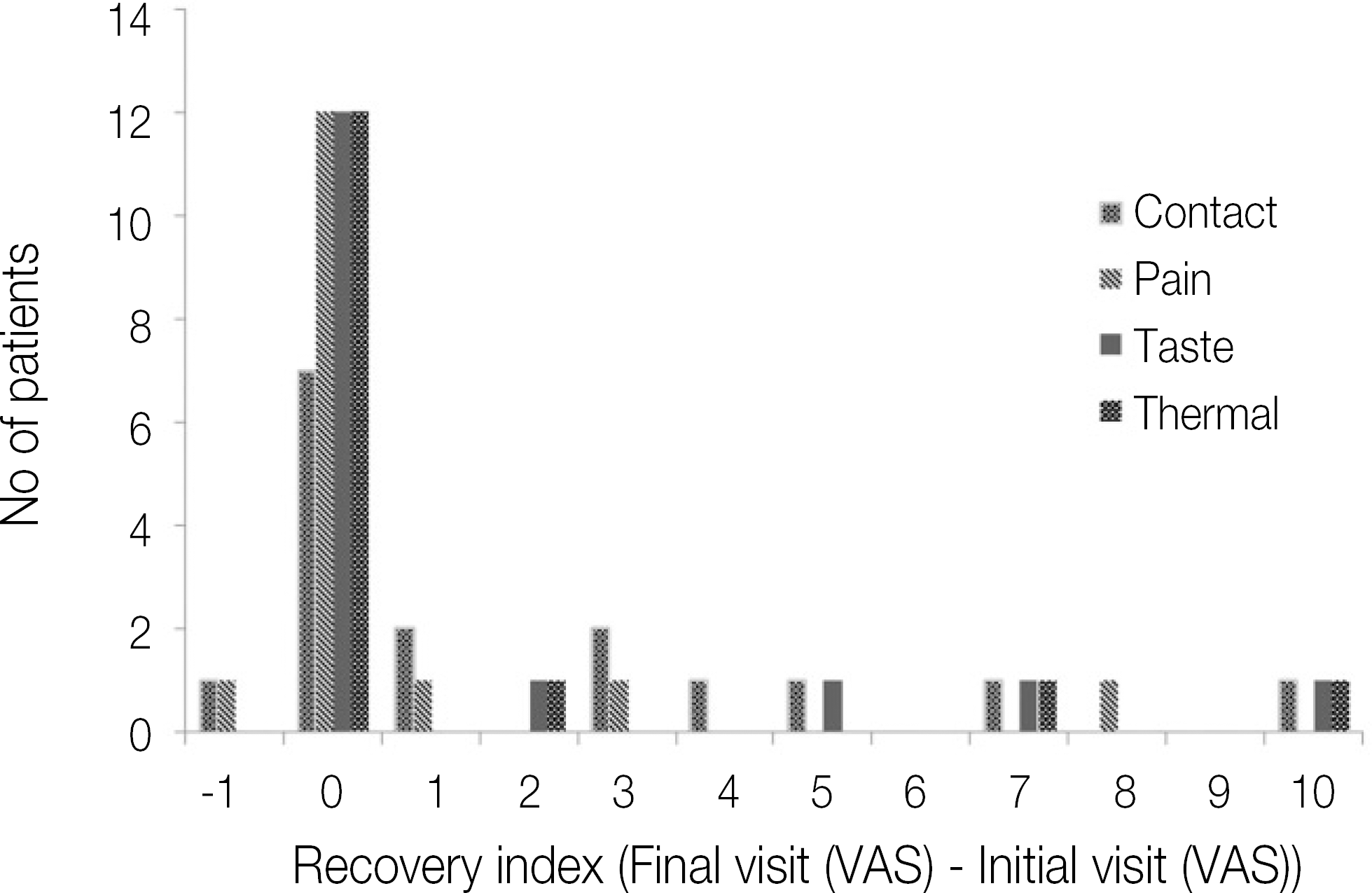 | Fig. 1.The degree of improvement of paresthesia and relief of pain just after lingual nerve injury based upon questionnaire (Recovery index). Contact, Contact threshold; Pain, Pain perception; Thermal, Thermal threshold Dong-Hwan Hong et al: Recovery of lingual nerve injury: retrospective observational study. J Korean Assoc Oral Maxillofac Surg 2011
|
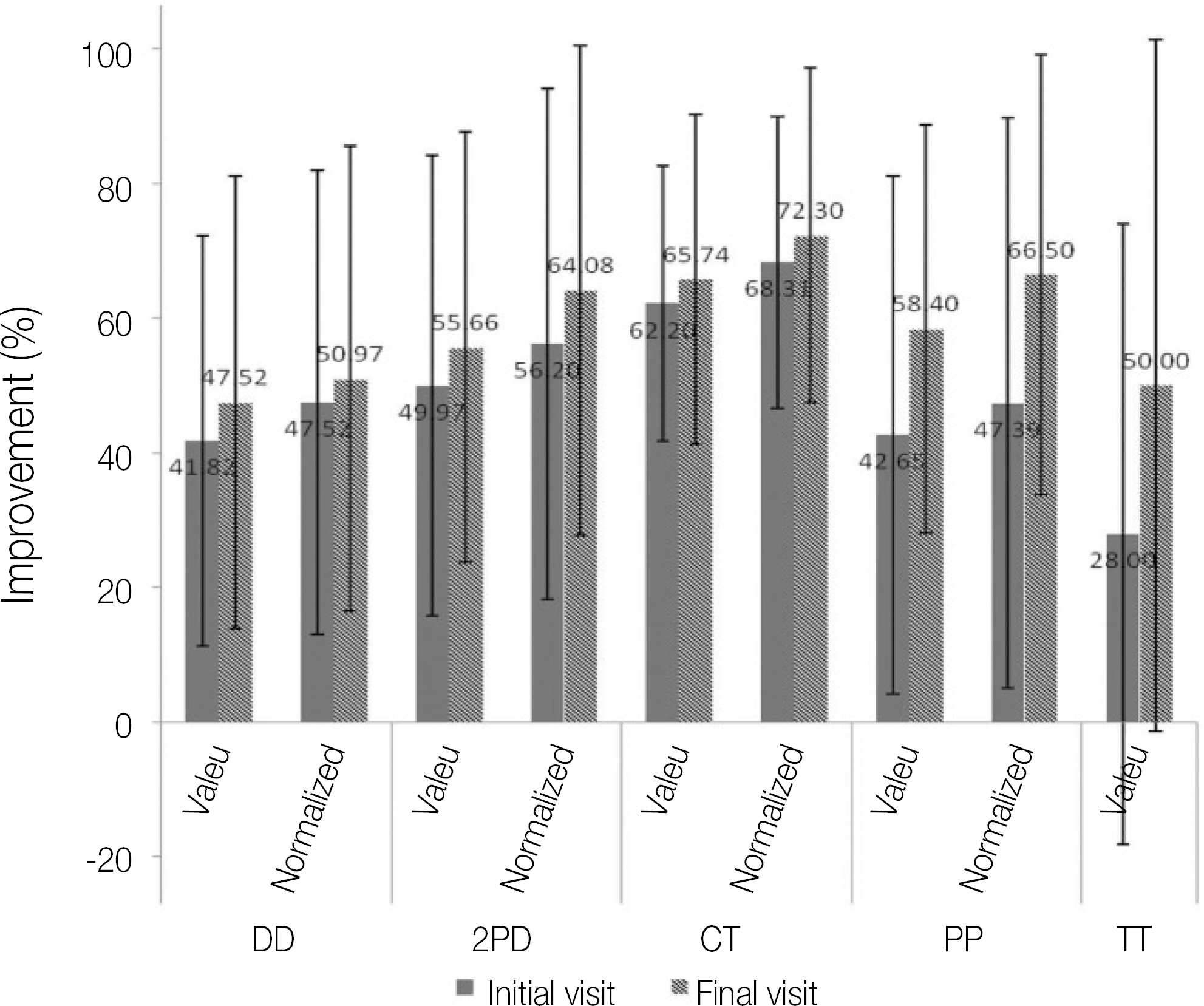 | Fig. 2.Comparison of average and standard deviation of each neurosensory examination (value1 and normalized result2) between initial and final visit in group treated by preservative treatment only. DD, Direction discrimination; 2PD, 2-point discrimination; CT, Contact threshold; PP, Pain perception; TT, Thermal threshold value1, measured result; normalized result2, ratio of measured result to that of normal side Dong-Hwan Hong et al: Recovery of lingual nerve injury: retrospective observational study. J Korean Assoc Oral Maxillofac Surg 2011
|
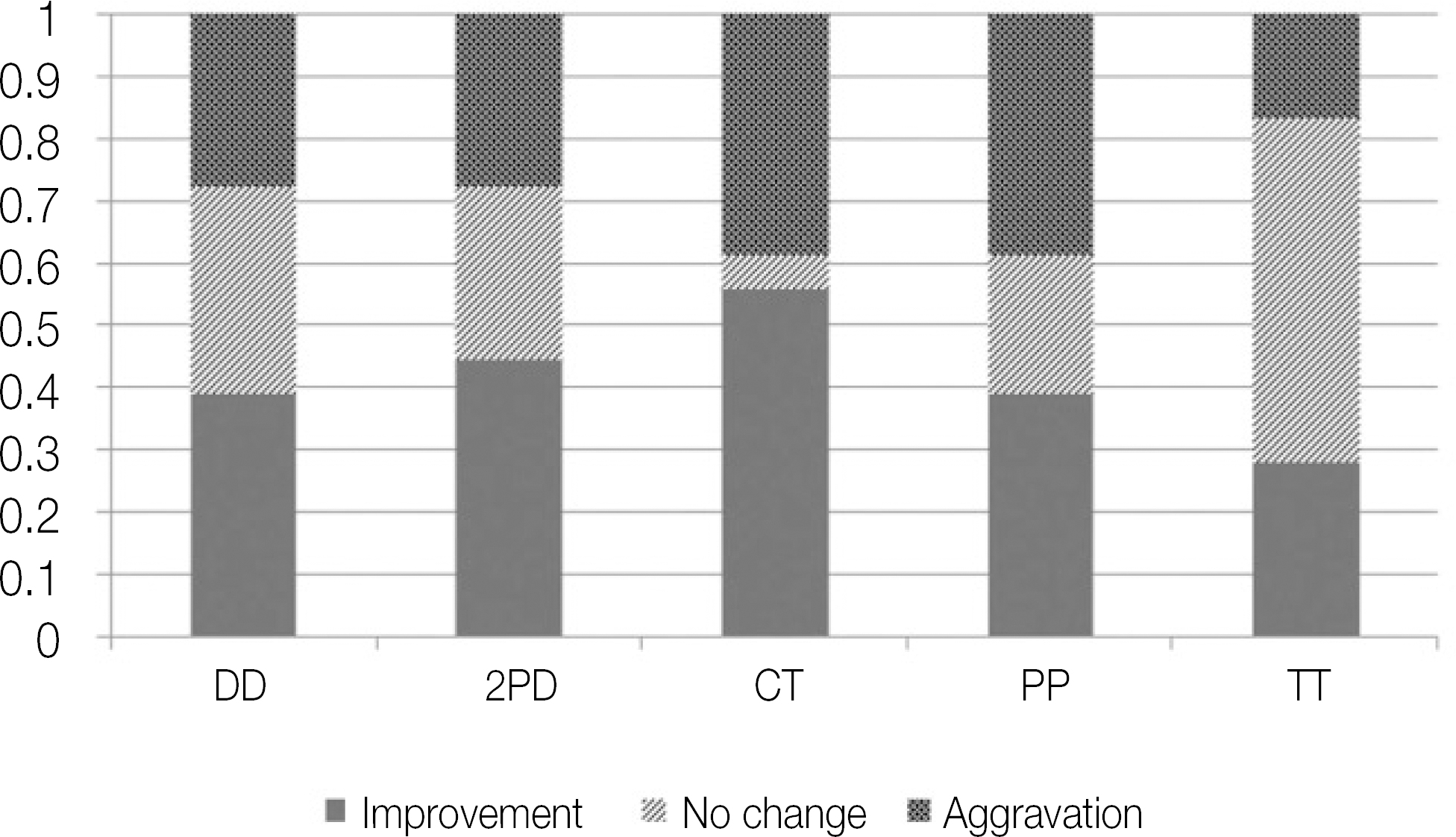 | Fig. 3.The ratio of improved, unchanged and aggravated patients to all patients at neurosensory test in group treated by preservative treatment only. DD, Direction discrimination; 2PD, 2-point discrimination; CT, Contact threshold; PP, Pain perception; TT, Thermal threshold. Dong-Hwan Hong et al: Recovery of lingual nerve injury: retrospective observational study. J Korean Assoc Oral Maxillofac Surg 2011
|
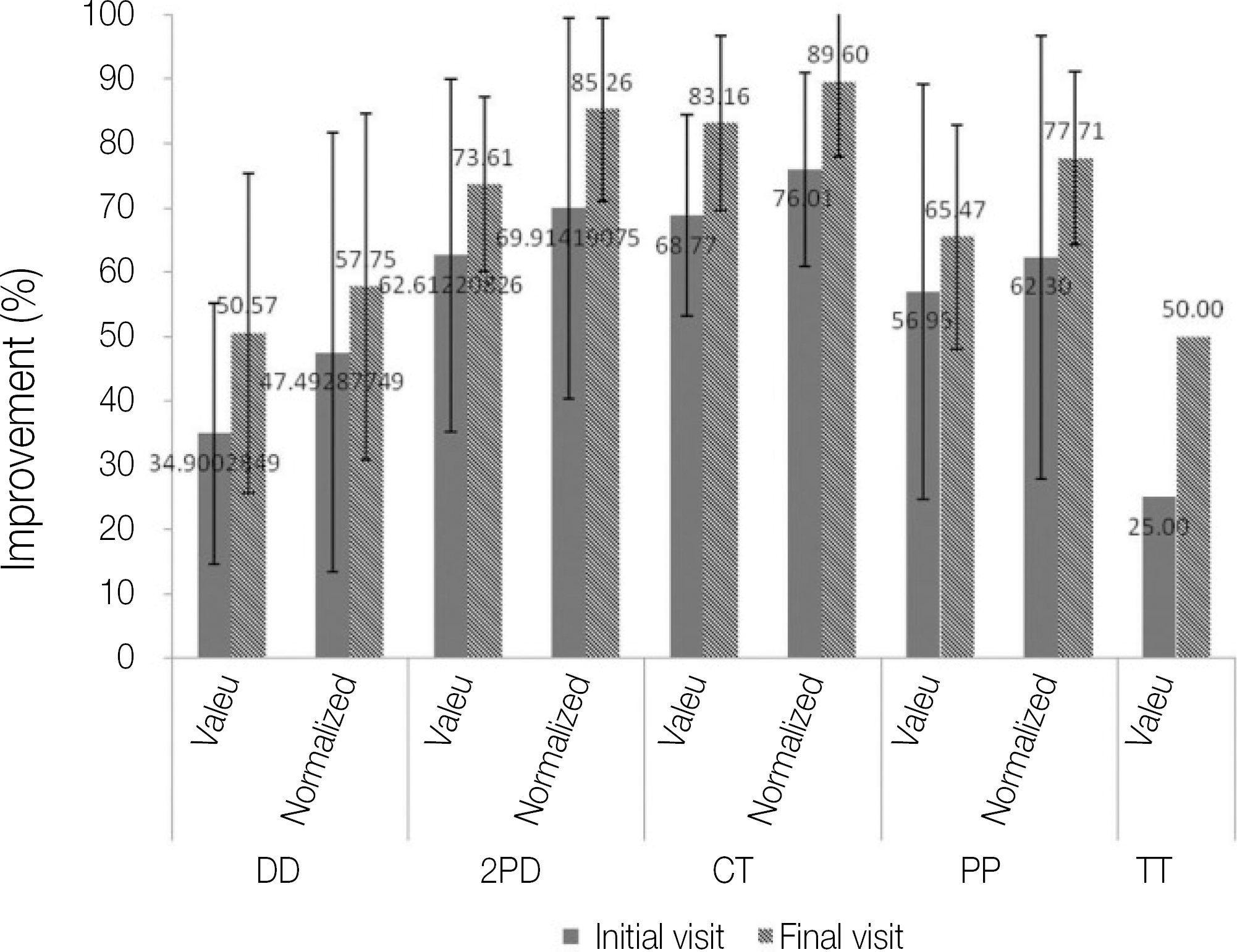 | Fig. 4.Comparison of average and standard deviation of each neurosensory examination (value1 and normalized result2) between initial and final visit in group which were treated by preservative treatment only and showed subjective improvement. DD, Direction discrimination; 2PD, 2-point discrimination; CT, Contact threshold; PP, Pain perception; TT, Thermal threshold. value1, measured result; normalized result2, ratio of measured result to that of normal side. Dong-Hwan Hong et al: Recovery of lingual nerve injury: retrospective observational study. J Korean Assoc Oral Maxillofac Surg 2011
|
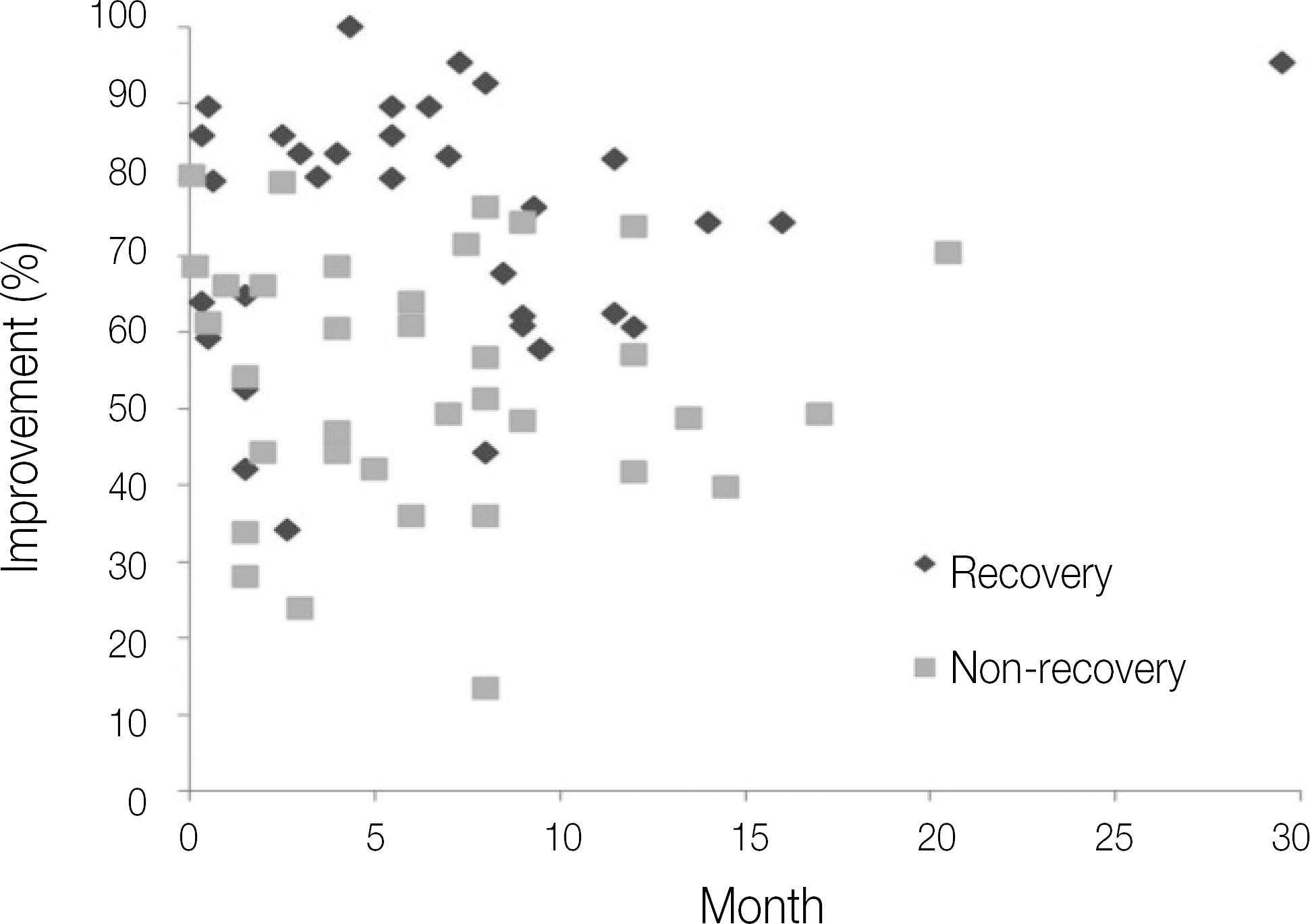 | Fig. 5.The change over time of perception threshold of two groups. Recovery, received preservative treatment and improved subjectively; Non-recovery, received preservative treatment but not improved. Dong-Hwan Hong et al: Recovery of lingual nerve injury: retrospective observational study. J Korean Assoc Oral Maxillofac Surg 2011
|
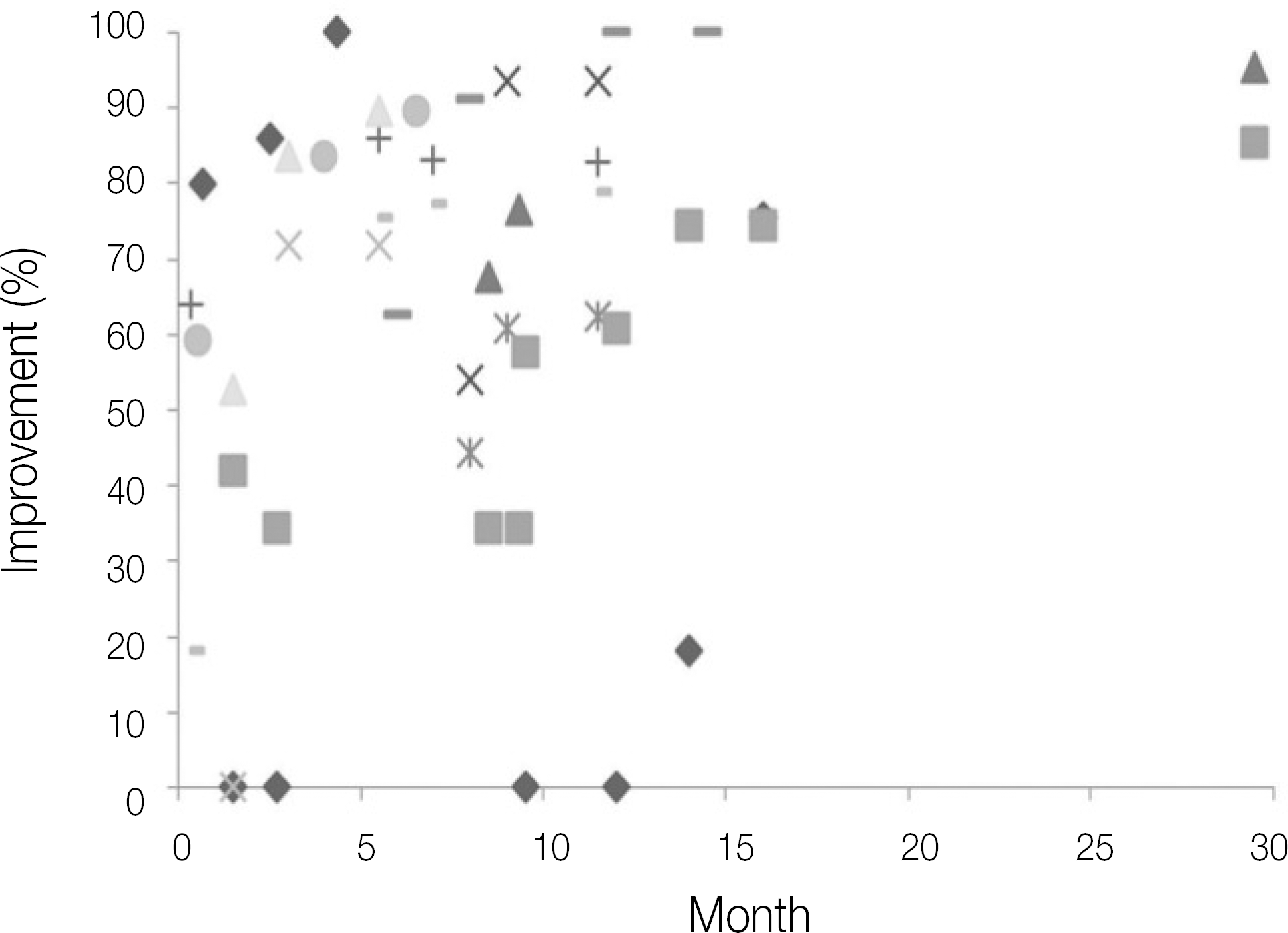 | Fig. 6.The change over time of results of neurosensory examinations at subjectively improved patients (n=8). Dong-Hwan Hong et al: Recovery of lingual nerve injury: retrospective observational study. J Korean Assoc Oral Maxillofac Surg 2011
|
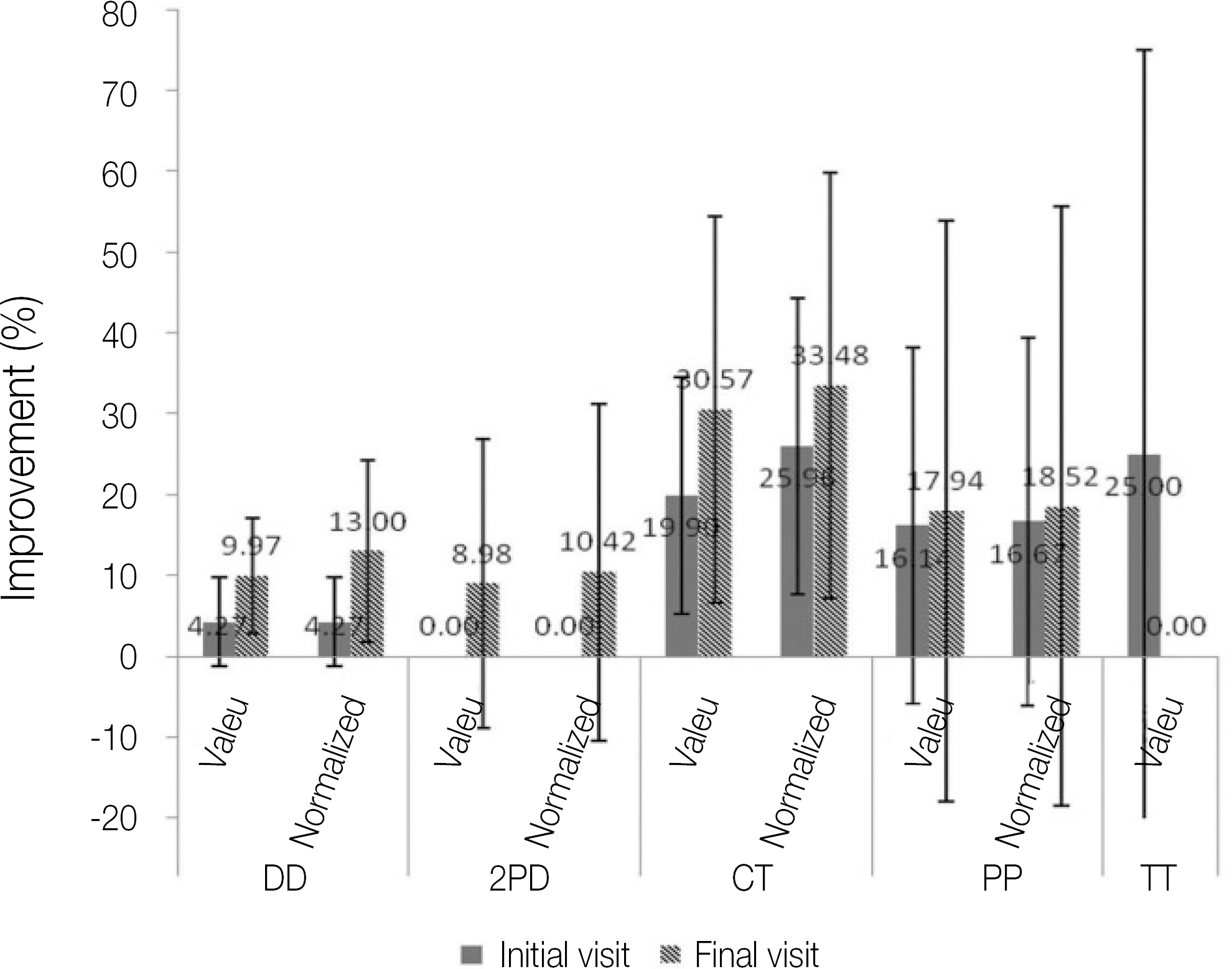 | Fig. 7.Comparison of average and standard deviation of each neurosensory examination(value1 and normalized result2) between initial and final visit in group which were treated by surgical treatment. DD, Direction discrimination; 2PD, 2-point discrimination; CT, Contact threshold; PP, Pain perception; TT, Thermal threshold. value1, measured result; normalized result2, ratio of measured result to that of normal side. Dong-Hwan Hong et al: Recovery of lingual nerve injury: retrospective observational study. J Korean Assoc Oral Maxillofac Surg 2011
|
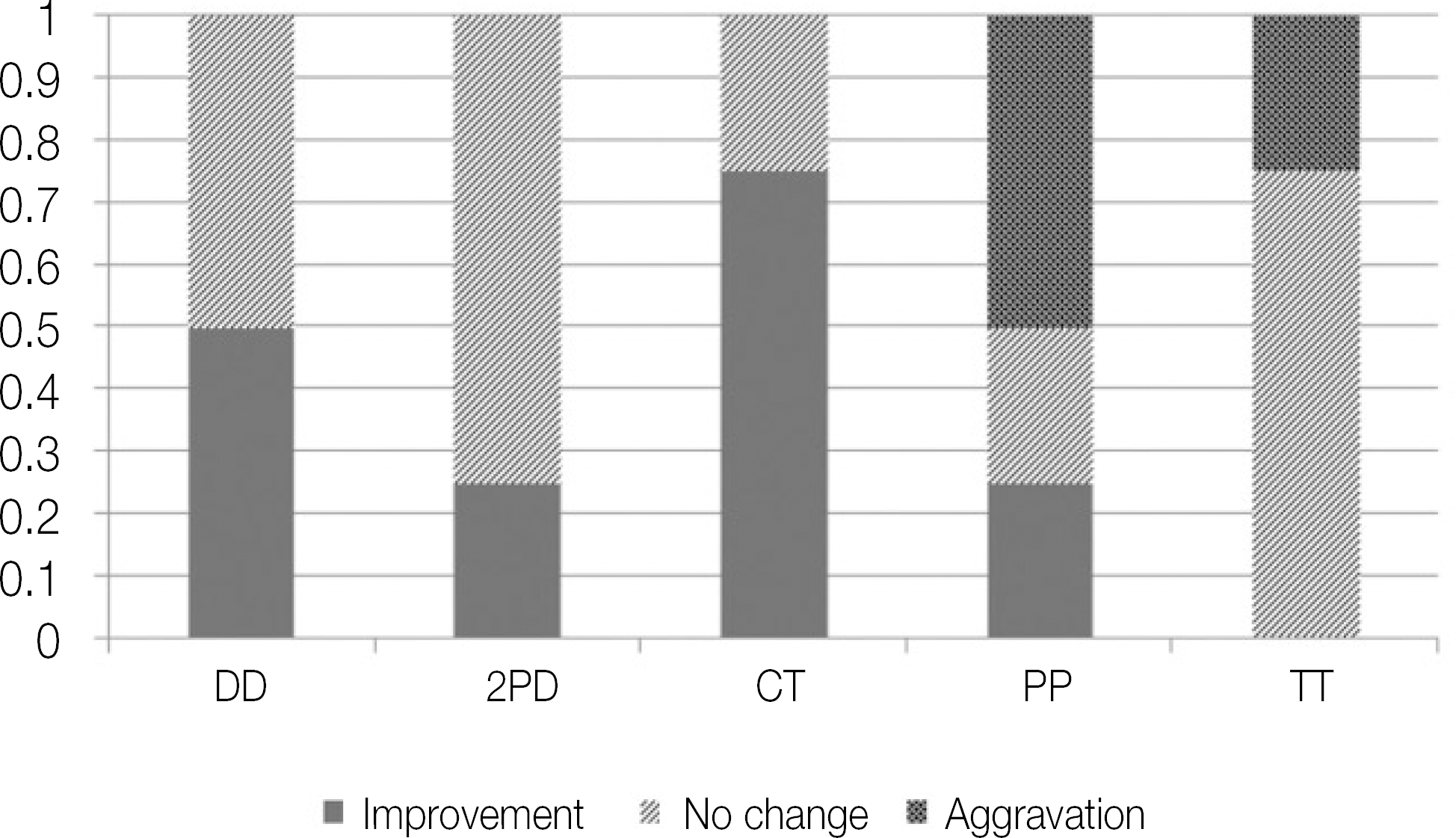 | Fig. 8.The ratio of improved, unchanged and aggravated patients to all patients at neurosensory test in group treated by surgical treatment. DD, Direction discrimination; 2PD, 2-point discrimination; CT, Contact threshold; PP, Pain perception; TT, Thermal threshold. Dong-Hwan Hong et al: Recovery of lingual nerve injury: retrospective observational study. J Korean Assoc Oral Maxillofac Surg 2011
|
Table 1.
The improvement of subjective prognosis according to each gender
| Gender | Number of patients | Improvement | No improvement |
|---|---|---|---|
| Male | 15 | 7 | 8 |
| Female | 23 | 10 | 13 |
Table
2. The improvement of subjective prognosis accordino to cause
| Cause | Number of patients | Improvement | No improvement |
|---|---|---|---|
| Extraction | 21 | 11 | 10 |
| Local anesthesia | 4 | 2 | 2 |
| Implant | 3 | 1 | 2 |
| Frauma | l | O | 1 |
| Incision and drainage | 1 | 0 | 2 |
Table 3.
The improvement of subjective prognosis according to age
| Age(yr) | Number of patients | Improvement | No improvement |
|---|---|---|---|
| 20s | 10 | 4 | 6 |
| 30s | 13 | 8 | 5 |
| 40s | 8 | 1 | 7 |
| 50s | 3 | 2 | 1 |
| 60 | 1 | 0 | 1 |
Table 4.
The comparison of statistic significance between degree of subjective improvement and the result of each neurosensory examination (P value=0.1)
| Examination | Subjective improvement | No subjective improvement | ||||||
|---|---|---|---|---|---|---|---|---|
| V1 | P | N2 | P | V1 | P3 | N2 | P | |
| DD | X | 0.144 | X | 0.345 | X | 0.889 | X | 0.859 |
| 2PD | X | 0.4 | X | 0.263 | X | 0.553 | X | 0.499 |
| CT | O | 0.069 | O | 0.069 | X | 0.214 | X | 0.441 |
| PP | X | 0.866 | X | 0.575 | X | 0.15 | X | 0.263 |
| TT | X | 0.317 | X | 0.317 | ||||




 PDF
PDF ePub
ePub Citation
Citation Print
Print


 XML Download
XML Download